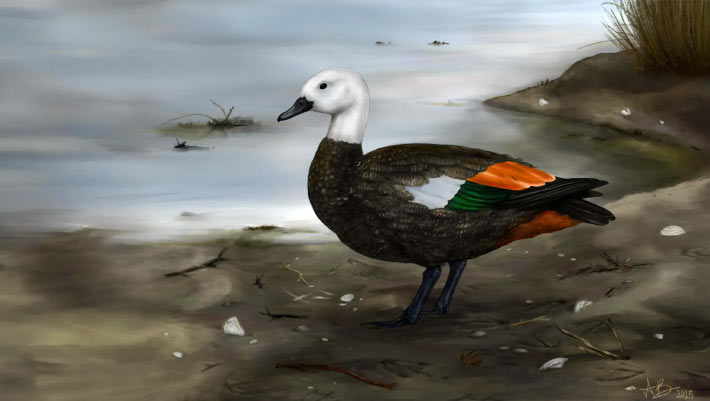A team of paleontologists from New Zealand and Australia has described a new extinct shelduck species from Holocene fossil bone deposits on the Rēkohu Chatham Islands.
An artistic reconstruction of a female Rēkohu shelduck (Tadorna rekohu) showing the darker plumage common in birds isolated on islands. Image credit: Sasha Votyakova / Te Papa.
Named the Rēkohu shelduck (Tadorna rekohu), the new species inhabited the Chatham Islands, an isolated archipelago 785 km east of mainland New Zealand.
“This archipelago comprises the main Chatham Island, as well as Rangihaute Pitt, Maung’ Re Mangere, Tapuaenuku Little Mangere, Hokorereoro South East Islands, and various islets,” said University of Otago’s Dr. Nic Rawlence and his colleagues.
“The islands were completely submerged during the Late Miocene to Early Pliocene.”
“Subsequent tectonic activity caused the island archipelago to re-emerge less than 3 million years ago.”
According to the team, the ancestors of the Rēkohu shelduck arrived on the Chatham Islands around 390,000 years ago during the Late Pleistocene.
“While this may seem like a short period of time, it is long enough to impact the species,” Dr. Rawlence said.
“In that time the Rēkohu shelduck evolved shorter, more robust wings and longer leg bones indicating it was going down the pathway towards flightlessness.”
“These changes were due to a range of factors, such as an abundance of food, lack of ground-dwelling predators, and windy conditions, so flying was not the preferred option.”
“In a case of use it or lose it, the wings start to reduce,” said Dr. Pascale Lubbe, also from the University of Otago.
“Flight is energetically expensive, so if you don’t have to fly, why bother.”
“The longer leg bones are more robust to support more muscle and create increased force for take-off — necessary when you have smaller wings.”
The researchers used ancient DNA and analyzed the shape of the bones to determine the Rēkohu shelduck is most closely related to the pūtangitangi paradise shelduck (Tadorna variegate) from New Zealand.
The Rēkohu shelduck spent more time on the ground than its cousin and became extinct prior to the 19th century.
“The presence of Rēkohu shelduck bones in early Moriori midden deposits suggests its extinction was due to over-hunting prior to the later European and Māori settlement of the islands in the 19th century,” the scientists said.
Their paper was published in the July 2025 issue of the Zoological Journal of the Linnean Society.
_____
Nicolas J. Rawlence et al. 2025. Ancient DNA and morphometrics reveal a new species of extinct insular shelduck from Rēkohu Chatham Islands. Zoological Journal of the Linnean Society 204 (3): zlaf069; doi: 10.1093/zoolinnean/zlaf069




























